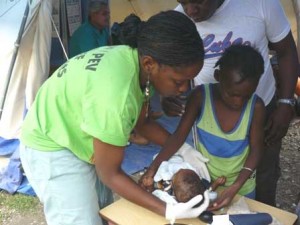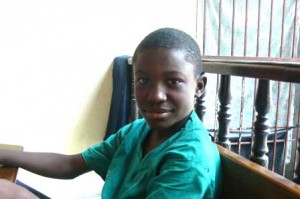With Cuba’s Doctors in Haiti

HAVANA TIMES, March 9 — Conner Gorry is in Haiti for the NGO Medical Education Cooperation with Cuba (Medicc), bringing her account of the work of Cuban physicians and other doctors and medical students accompanying them. She said on Monday: “I do a lot of listening here, asking far fewer questions than I usually would and I never inquire about family…”
HT republishes Gorry’s latest blog entry.
TWO OF THE 170,000+ “CASES”
By Conner Gorry
I do a lot of listening here, asking far fewer questions than I usually would and I never inquire about family…
Case I
There’s a light drizzle falling as the busload of doctors, nurses, and 5th year medical students head out for the morning’s work in the Cuban health posts known as Belair I and Belair II. Stuttering through the clogged, rubble-strewn streets of Port-au-Prince, the bus is a veritable United Nations of medical personnel: there are Cuban doctors of course, but also Colombian, Brazilian and Panamanian physicians, plus Cuban nurses and Haitian medical students from the Latin American Medical School (ELAM) – all trained in Cuba. Ironically, as we inch past elders selling charcoal from reed baskets and young toughs peddling black market antibiotics, an armored vehicle full of UN blue bonnets chugs past.
Belair I and Belair II are misnomers – these are not pretty places and the air is anything but. The camps are sprawling, muddy settlements with shelters made from plastic sheets and sticks, cardboard and corrugated metal packed cheek by jowl. Small children, barefoot and bare-bottomed often, beautiful and innocent always, suck their thumbs and watch as we walk past. In the middle of this stark reality stand the health posts: simple tents with a couple of rough-hewn benches and chairs where patients wait to be seen and treated for free by the Henry Reeve Emergency Medical Contingent.
“We were told this was a very rough area, with a lot of crime when we learned where we would be working,” said Arnaldo Santa Cruz, a physical therapist from Havana. But with over 6 weeks in operation, the Cubans are respected and protected by Belair’s community. Today, like every day, women with babies and their young children, grandmothers and the odd man, wait patiently to see one of the “Cuban doctors” as the entire group is known. At the end of a long morning diagnosing and treating acute respiratory infections, scabies, and other common conditions plaguing Port-au-Prince’s population, a young girl arrives with a too-small bundle swaddled in a towel.
The girl is eight, her baby brother, the swaddled bundle, is just 4 months old. Dr. Yahimely Pezcalderón, a family doctor from Cuba’s Cienfuegos province, lays the infant gently on the table. He’s clearly malnourished and is running a fever of 103°. With Jude Celerin, a 5th year Haitian ELAM student translating, Dr Pezcalderón learns that this 8-year-old girl has been taking care of her baby brother and little sister since the earthquake. Their mother is in the hospital and the prognosis isn’t good. Dr Pezcalderón prescribes the medicines the baby needs to control the fever, but she is doubtful. “I don’t like seeing children come to the health posts alone. They usually don’t read and it’s hard for them to understand the dosage and how to take the medicine. I’ll make sure they come back tomorrow and follow up, but…” We haven’t seen them since, but it has been raining, and patients typically stay away in the rain.
Case II
Son Son, as he is known among us, is a beautiful young man who makes friends easily. His full name is Mickelson Brun and he’s just 13 years old, though responsibilities assumed by him since the earthquake have forced Son Son to grow up fast.

His home was destroyed in the quake and with nowhere to go, the Brun family – Son Son, his mother, father, and 4-year old sister – erected a sheet-and-stick shelter in the park facing the crumbling presidential palace. This is a pestilent, infernal place swirling with dust when the sun is out, and a pestilent, infernal place thick with mud when it rains. Son Son’s mom, Myrlande, escaped from the earthquake unscathed, but was already in poor health, which conditions in the tent city exacerbated. Looking for a solution to her multiple health problems, Son Son sought out the free services of the Cuban team when he met one of the Haitian ELAM graduates working with them.
Myrlande is a typical survivor’s case, of which the Cubans have seen thousands: anemic and malnourished, running a fever and with a tentative diagnosis of more serious infectious disease that only laboratory tests can nail down. In short, she is in very bad shape. The doctors treating Myrlande don’t need a translator – the Bruns spent nearly a decade living in the Dominican Republic trying to eke out a living and Son Son speaks Spanish well. The doctors remit her for a blood work-up and X-rays in Port-au-Prince’s Renaissance Hospital, a public hospital staffed by Cubans, and prescribe fever reducers in the meantime. They bid the duo goodbye.
But the next day, Son Son is back. And the next and the next. He hangs around with his winning smile and quick intelligence, translating for the Cuban doctors and ELAM graduates from other countries working at the health post at Carre Four Feuilles. He is an asset, a tremendous help in times of tremendous need. Soon, Son Son is accompanying the doctors six days a week, volunteering his translating services and making fast friends with everyone on the team – Cubans, Hondurans, Uruguayans, Mexicans, and Brazilians. He learns to recognize symptoms and perfects his health vocabulary.
Son Son
On workdays, he rides back to the Cuban camp with the doctors to eat lunch, learn about different countries represented on the team, and watch TV. Son Son’s life regains rhythm and purpose. He is given a child-sized uniform of the Henry Reeve International Contingent – shirts of green surgery scrub material printed with the Cuban and Haitian flags. When members of the Contingent learn the Bruns have no roof for their shelter, they find him one of the blue plastic tarps you’ve seen in every post-disaster report on CNN. He becomes part of an international family hailing from all over the world.
“I’ve lost all my friends, Conny,” he tells me one day as we walk to the bus that will take us to the health post. I say nothing, waiting for him to elaborate about his friends that perished in the quake. I do a lot of listening here, asking far fewer questions than I usually would and I never inquire about family, waiting for folks to broach personal subjects. “They all left to work in different parts of the country.” It takes me a moment to realize Son Son is referring to the scores of ELAM doctors who have now been posted to health centers and hospitals throughout Haiti. I hope my sigh of relief isn’t audible – departing doctors is much easier to address than dead classmates. “Oh, Son Son. I know you miss them, but don’t worry. There are more arriving tomorrow and I know you’ll make a lot of new friends.”
But the prognosis for Son Son’s mom is another thing: it is not good. Her immune system is extraordinarily weak and may not be able to resist the multiple ongoing assaults on it in today’s Haiti. “She’s very good,” he tells me when I ask after her. The Haitians are incredibly gracious and stronger still; of course he tells me she’s doing well. Still, I go to sleep thinking of Myrlande and pray to whoever will listen that it doesn’t rain tonight – just one more night without rain, please. Son Son still comes to work every day, with his gorgeous smile, giving everyone a hug in turn. Whether he dreams of becoming a doctor, nurse, health technician, engineer, or teacher, everyone is pulling for a scholarship in Cuba for young Son Son. Sí, se puede.





